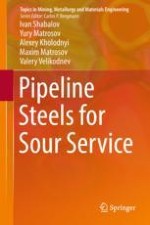2019 | Buch
Pipeline Steels for Sour Service
verfasst von: Dr. Ivan Shabalov, Prof. Dr. Yury Matrosov, Ph.D. Alexey Kholodnyi, Ph.D. Maxim Matrosov, Dr. Valery Velikodnev
Verlag: Springer International Publishing
Buchreihe : Topics in Mining, Metallurgy and Materials Engineering
